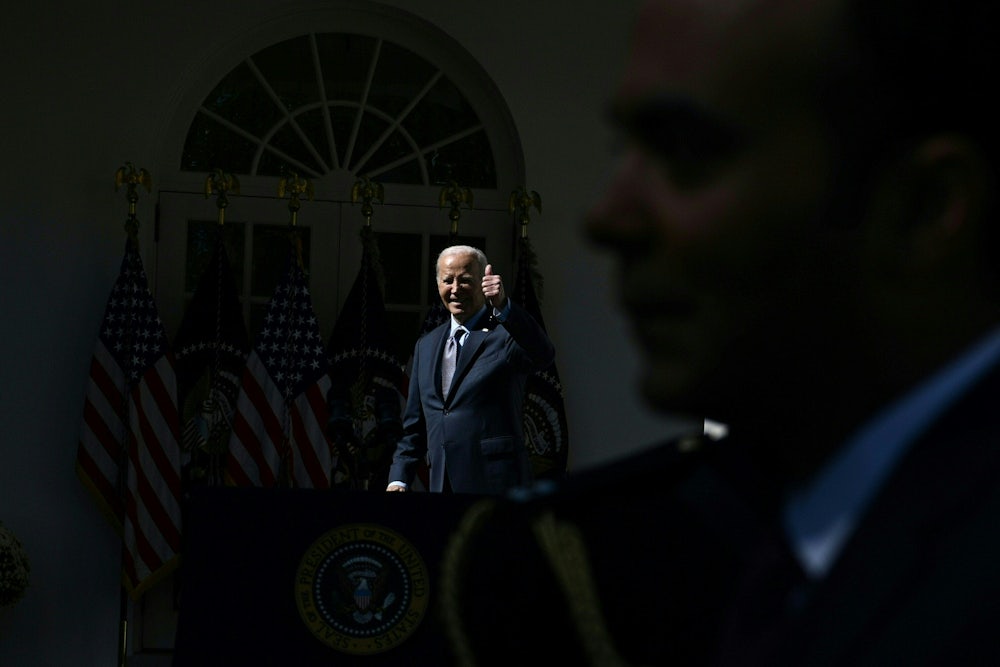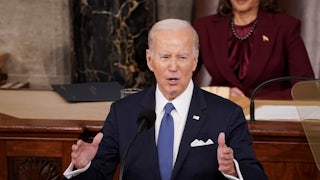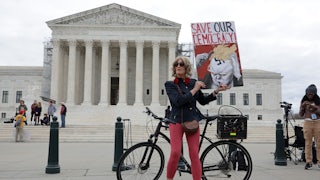White House leaks in advance of the State of the Union address have telegraphed Joe Biden’s intention to stress how age and experience have made him a successful president. The crux of Biden’s argument is likely to be that his seven terms in the Senate have given him a preternatural ability to negotiate compromises like the $1 trillion infrastructure bill in 2021. He may also claim that his half-century in Washington has equipped him to understand hinge points of history like the struggle for democracy against Donald Trump in 2024.
The limitations of this approach lie in the difficulty that voters have in understanding how any normal president operates behind the scenes. (Trump, as always, is the exception, since dozens of former top officials were eager to publicly testify to his crazed unfitness for office.) Democrats contending that an 81-year-old Biden is great at governing are akin to Clinton aides who insisted in 2016, “Hillary is really funny—in private.”
In recent weeks, the overprotective Biden staff has punched a few holes in the bubble wrap that normally shrouds the president. Biden made cracks about his age in an 11-minute appearance on Seth Meyers’s talk show. And New Yorker writer Evan Osnos scored a rare Oval Office interview with Biden augmented with on-the-record conversations with often near-invisible White House aides. Implicitly rebutting GOP-fanned rumors of presidential senility, Osnos testified to Biden’s mental capacity: “His voice is thin and clotted, and his gestures have slowed, but, in our conversation, his mind seemed unchanged. He never bungled a name or a date.”
Even a stumble-free delivery of the State of the Union address, punctuated by clever ad-libs, is unlikely to dispel concerns about Biden’s age. The political problem, which has been long festering, has accentuated since the release of special counsel Robert Hur’s report, which combined legally exonerating Biden on his handling of classified documents with some nasty (and unproven) lines about the president’s memory and mental capacity. With a New York Times/Siena College Poll showing that 73 percent of Biden supporters say that the president is too old to be effective, these voter concerns are unlikely to be stemmed by joking with TV comics or granting the occasional friendly magazine interview.
Novelists and playwrights are often advised: Show, don’t tell. The same dictum applies to presidents. How much more powerful it would be to show the president doing his job in the Oval Office rather than just talking about the burdens of office in speeches and interviews. What is mostly forgotten is that prior presidents also wrestled with the dilemma of how to take Americans into Cabinet sessions and staff meetings to reveal the realities of governing. These experiments in presidential transparency did not always work, but they are worth reexamining as Biden struggles to convince voters that he would be a capable second-term president in his eighties.
In the spring of 1953, newly elected Dwight Eisenhower embarked on what historian David Greenberg dubbed “one of the loopier experiments in the annals of presidential spin.” Attempting to update Franklin Roosevelt’s radio “Fireside Chats,” Ike set out to transform himself into what was described within the White House as “the TV president.”
The initial idea: Televise a Cabinet meeting. Fearing spontaneity, the White House commissioned a 44-page script from Eisenhower’s campaign advertising agency and prompted Cabinet members with cue cards. The predictable outcome was a stilted talk show that proved that Ike’s Cabinet was not selected based on acting ability. Undaunted, Eisenhower resorted to the gimmick again in October 1954, featuring Secretary of State John Foster Dulles droning on about NATO with the verve of a corporate attorney commenting on tax code changes.
Television by its nature turns everyone on camera into a performer. That is why a far more lasting approach was pioneered by Harry Truman in November 1950, when he granted John Hersey, a Pulitzer Prize winner writing for The New Yorker, an unprecedented window on White House decision-making. At the time, Hersey was one of the most famous writers in America, both for his wrenching nonfiction account of six survivors of the atomic bomb that leveled Hiroshima and for his novel, The Wall, which depicted the doomed Warsaw Ghetto uprising against the Nazis in 1943. In late 1950, Truman (like Biden today) was an unpopular president with approval ratings below 40 percent, grappling with a war on the Korean peninsula.
Hersey had been granted a short interview with Truman, a self-taught lover of history who revered Plutarch’s Lives, biographical sketches of great Greeks and Romans. Instead of asking the predictable reporter questions, Hersey used his time to appeal to Truman’s obligation to history. The result: Hersey was soon allowed to roam the Truman administration for almost three weeks—attending staff meetings, interviewing everyone, and accompanying the peripatetic president on his morning walks.
Hersey’s five-part series, which ran in The New Yorker in April and May 1951, was brimming with insights and keyhole glimpses of the Truman presidency. But one event shimmers as the most dramatic behind-the-scenes presidential moment ever witnessed by a journalist. At the beginning of a seemingly routine November 28, 1950, morning staff meeting, Hersey noted that Truman “seemed preoccupied ... obviously thinking about something else.” The president allowed the 11 staff members in his office to individually discuss the pressing issues of the day, ranging from steel prices to aid to Yugoslavia. Jokes were told as the president gamely tried to maintain a jovial tone.
Only after everyone had spoken at length did Truman solemnly reveal a “terrible message” that he had received early that morning from General Douglas MacArthur, commanding U.S. and allied troops in Korea. “MacArthur said there were 260,000 Chinese troops against him out there,” Truman announced. “He says he’s stymied.… It’s no longer a question of a few so-called volunteers. The Chinese have come in with both feet.” The Chinese attack transformed the Korean War into a stalemate that would drag on until the 1953 Armistice.
What Hersey conveyed by being in the room on that November morning was how calmly and orderly Truman responded to the crisis. Truman informed his staff that there would be a special Cabinet meeting that afternoon, Secretary of State Dean Acheson was at that moment briefing congressional leaders, the president was contemplating declaring a national emergency, and he planned to make a radio and television address to the nation in the days ahead.
Hersey adhered to negotiated ground rules about what was on and off the record during his time around Truman. Only 30 years later did Hersey describe another secret presidential meeting in which Truman and his top aides debated how to contain red-baiting Wisconsin Senator Joseph McCarthy. Not allowed to take notes at the off-the-record session, Hersey recalled that Truman refused to spread the contents of a dossier detailing McCarthy’s out-of-control personal behavior.
A quarter-century later, Hersey wangled a week’s access to the White House of another underestimated president, Gerald Ford, whom the writer had known as a Yale football coach in the 1930s. In the article, which filled an entire issue of The New York Times Magazine in April 1975, Hersey boasts that he was “given access to a President of the United States of a sort no journalist has ever had.”
Not exactly, thanks to Secretary of State Henry Kissinger. The president made clear to Hersey from the beginning that the only events that were off limits were Ford’s “daily meetings with Henry.” At the time, Cambodia was about to fall to the Khmer Rouge, the South Vietnamese government was on the verge of toppling, and Kissinger was attempting to practice shuttle diplomacy in the Middle East. Leaving Kissinger out of the story was akin to telling the tale of George W. Bush’s first term and the Iraq War without ever mentioning Vice President Dick Cheney.
The control-freak aides who surround Biden would be unlikely to grant a reporter the kind of access that Hersey received from Truman and, to a lesser extent, Ford. We also inhabit a radically different media environment, in which no journalist (this side of Tucker Carlson) would ever be believed by MAGA Republicans and Fox News viewers. But right-wing media haters are not the swing voters Biden needs to attract in a close election. Polling shows that these voters are concerned about Biden’s age—but also worried about Trump’s temperament. Finding a way to demonstrate to these voters that Biden is not only mentally sound but capable of guiding the country through a sea of crises is his campaign’s most daunting task in this election. But frightened of potential Biden gaffes and slipups, his advisers so far have responded largely by shielding the president from media scrutiny—and public view.
Despite the risks of an open White House, Biden would have far more to gain politically by allowing a few reporters to witness firsthand how his five decades of hard-earned wisdom in Washington shape his decisions in the run-up to an election that is likely to pivot around the age issue.




